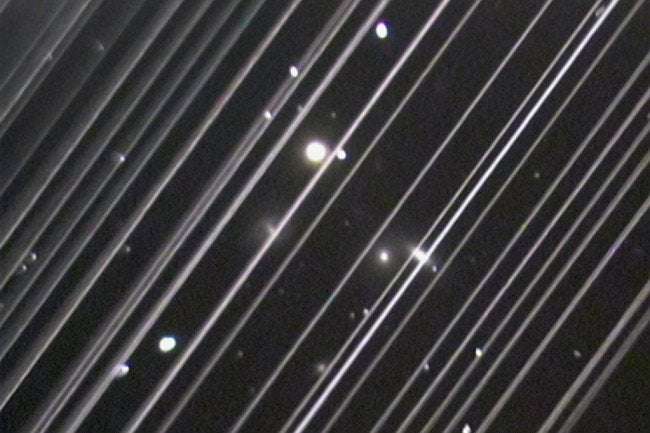To beam internet connectivity back to Earth, many of these will have a shallow orbit. There also has to be thousands of them to provide global coverage. By the time SpaceX is finished, the company could have as many as 40,000 new spacecraft in orbit. They’ve already announced plans to launch 60 satellites every other week through 2020. For comparison, there are currently just over 2,000 active satellites in orbit right now. SpaceX isn’t the only company with visions of dominating satellite internet, either. A handful of competitors, including Amazon, intend to launch their own constellations.
For its part, SpaceX has started experimenting with low-reflectivity materials to coat the satellites. However, from an engineering perspective, satellites need reflective materials to keep cool.
“The problem is made worse because the satellites are in low-Earth orbit,” Odenwald says. “They’re brighter because they’re lower. And because there are so many of them, it means (astronomers) get maybe as much as an hour of bright streaks going across their sensitive photographic detectors.”
Those numbers are the real worry for scientists. Astronomers have already moved their telescopes to increasingly remote locations to avoid light pollution. But there’s nothing they can do to avoid bright satellites streaking through and ruining their images.
Odenwald says that inspired him to launch the Satellite Streak Watcher project and ask citizen scientists all over the world to take pictures of these satellites with their cellphones.
To take part, you’ll need a very basic tripod and a reasonably new smartphone. The veteran astronomer says he’s been amazed at the quality of night-sky images now coming from smartphones. Many phones are now sensitive enough to capture the Milky Way, and he’s even seen detailed shots of the International Space Station taken by holding a phone up to a telescope eyepiece.
“If you’ve got a new phone, it’s probably good enough to do this, and several of them have night sky modes, which is perfect,” he adds. Even phones dating back to 2016 or so should be able to photograph these satellites in about four seconds.
You’ll want to master your phone’s long exposure or night sky setting before heading outside. On older iPhones, you can also capture a Live image and set the exposure to 10 seconds. These work differently than traditional DSLR cameras, which leave the shutter open to capture longer exposures, but the end result is very similar.
You’ll also need to know when the satellites are passing overhead. To find out, you can go to Heavens-Above.com and enter your location. The website will give you a list of satellites and the times that they’re passing over your region. Setup your tripod in advance and point it at the region you want to photograph, then wait for the satellite to appear. To upload your images, simply go to the Satellite Streak Watcher project website and include your exposure and the background constellation.
Even astrophotographers with DSLRs are welcome to contribute. They should use a lens wide enough to capture a broad swath of the night sky, but not one that’s so wide it distorts the field. About a 50mm lens should be perfect.
Odenwald says there’s not a clearly defined scientific end goal at the moment. Rather, he’s hoping to document these streaks for a five-year period so that one day, astronomers can tap into the photos and study how satellite streaks have changed over time.
Throughout the history of astronomy, all-sky surveys -- traditionally done with much larger telescopes -- have proven pivotal to a broad range of research, he points out. And the ways those images proved useful wasn’t always anticipated by the astronomers who gathered them.
“We could have 5,000 to 10,000 of these satellites buzzing around low-Earth orbit at some point,” Odenwald says. If nothing else, “you could do before and after photos to show how much more annoying the sky is than it used to be.”

EquiliMario on March 2nd, 2020 at 18:51 UTC »
But every phone has a different light sensor. How are they going to normalise the submissions?
DerSpanischGamer on March 2nd, 2020 at 18:44 UTC »
My smartphone can't even take pictures of the moon :/
dipdopthe15rd on March 2nd, 2020 at 17:00 UTC »
I wish we had documentation of the light pollution
Satellites will impact astronomers and hobbyists ability to view the sky with their telescopes and equipment, from Earth.
But light pollution has ruined everyone's ability to just look up and see the stars/milkway